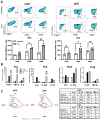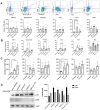Dendritic Cells Pulsed with HAM/TSP Exosomes Sensitize CD4 T Cells to Enhance HTLV-1 Infection, Induce Helper T-Cell Polarization, and Decrease Cytotoxic T-Cell Response
- PMID: 39339919
- PMCID: PMC11436225
- DOI: 10.3390/v16091443
Dendritic Cells Pulsed with HAM/TSP Exosomes Sensitize CD4 T Cells to Enhance HTLV-1 Infection, Induce Helper T-Cell Polarization, and Decrease Cytotoxic T-Cell Response
Abstract
HTLV-1-associated myelopathy/tropical spastic paraparesis (HAM/TSP) is a progressive demyelinating disease of the spinal cord due to chronic inflammation. Hallmarks of disease pathology include dysfunctional anti-viral responses and the infiltration of HTLV-1-infected CD4+ T cells and HTLV-1-specific CD8+ T cells in the central nervous system. HAM/TSP individuals exhibit CD4+ and CD8+ T cells with elevated co-expression of multiple inhibitory immune checkpoint proteins (ICPs), but ICP blockade strategies can only partially restore CD8+ T-cell effector function. Exosomes, small extracellular vesicles, can enhance the spread of viral infections and blunt anti-viral responses. Here, we evaluated the impact of exosomes isolated from HTLV-1-infected cells and HAM/TSP patient sera on dendritic cell (DC) and T-cell phenotypes and function. We observed that exosomes derived from HTLV-infected cell lines (OSP2) elicit proinflammatory cytokine responses in DCs, promote helper CD4+ T-cell polarization, and suppress CD8+ T-cell effector function. Furthermore, exosomes from individuals with HAM/TSP stimulate CD4+ T-cell polarization, marked by increased Th1 and regulatory T-cell differentiation. We conclude that exosomes in the setting of HAM/TSP are detrimental to DC and T-cell function and may contribute to the progression of pathology with HTLV-1 infection.
Keywords: HAM/TSP; HTLV-1; T cells; dendritic cells; exosomes.
Conflict of interest statement
The authors declare no conflict of interest.
Figures








Similar articles
-
Human T-lymphotropic virus type 1 (HTLV-1) and cellular immune response in HTLV-1-associated myelopathy/tropical spastic paraparesis.J Neurovirol. 2020 Oct;26(5):652-663. doi: 10.1007/s13365-020-00881-w. Epub 2020 Jul 23. J Neurovirol. 2020. PMID: 32705480 Free PMC article. Review.
-
Human T cell lymphotropic virus type I (HTLV-I)-specific CD4+ T cells: immunodominance hierarchy and preferential infection with HTLV-I.J Immunol. 2004 Feb 1;172(3):1735-43. doi: 10.4049/jimmunol.172.3.1735. J Immunol. 2004. PMID: 14734756
-
HTLV-I-associated myelopathy/tropical spastic paraparesis (HAM/TSP): the role of HTLV-I-infected Th1 cells in the pathogenesis, and therapeutic strategy.Folia Neuropathol. 2009;47(2):182-94. Folia Neuropathol. 2009. PMID: 19618340 Review.
-
Imbalanced IL10/TGF-β production by regulatory T-lymphocytes in patients with HTLV-1-associated myelopathy/ tropical spastic paraparesis.BMC Infect Dis. 2024 Jun 28;24(1):652. doi: 10.1186/s12879-024-09494-8. BMC Infect Dis. 2024. PMID: 38943078 Free PMC article.
-
IFN-gamma production in response to Tax 161-233, and frequency of CD4+ Foxp3+ and Lin HLA-DRhigh CD123+ cells, discriminate HAM/TSP patients from asymptomatic HTLV-1-carriers in a Peruvian population.Immunology. 2009 Sep;128(1 Suppl):e777-86. doi: 10.1111/j.1365-2567.2009.03082.x. Epub 2009 Feb 17. Immunology. 2009. PMID: 19740339 Free PMC article.
Cited by
-
CXCL-10 in Cerebrospinal Fluid Detects Neuroinflammation in HTLV-1-Associated Myelopathy with High Accuracy.Viruses. 2025 Jan 12;17(1):89. doi: 10.3390/v17010089. Viruses. 2025. PMID: 39861878 Free PMC article.
References
-
- Araujo A., Bangham C.R.M., Casseb J., Gotuzzo E., Jacobson S., Martin F., Penalva de Oliveira A., Puccioni-Sohler M., Taylor G.P., Yamano Y. Management of HAM/TSP: Systematic Review and Consensus-based Recommendations 2019. Neurol. Clin. Pract. 2021;11:49–56. doi: 10.1212/CPJ.0000000000000832. - DOI - PMC - PubMed
-
- Clements D.M., Crumley B., Chew G.M., Davis E., Bruhn R., Murphy E.L., Ndhlovu L.C., Jain P. Phenotypic and Functional Analyses Guiding Combination Immune Checkpoint Immunotherapeutic Strategies in HTLV-1 Infection. Front. Immunol. 2021;12:608890. doi: 10.3389/fimmu.2021.608890. - DOI - PMC - PubMed
Publication types
MeSH terms
Substances
Grants and funding
LinkOut - more resources
Full Text Sources
Research Materials
Miscellaneous

